BMNG7311 Assignment: Business Management and Strategic Analysis
VerifiedAdded on 2023/01/23
|12
|3116
|90
Homework Assignment
AI Summary
This assignment addresses key aspects of business management and strategic planning. It begins by exploring Mintzberg's 5 Ps of strategy and identifying sources of competitive intelligence, such as Alexa Rank and CrunchBase. The assignment then analyzes the mission, vision, and values of Nedbank. Finally, it delves into the sustainability practices of Pick n Pay, examining its business model, value chain, and commitment to ethical and environmental responsibility. The analysis highlights Pick n Pay's focus on food security, ethical behavior, and stakeholder relationships, concluding that Pick n Pay is a sustainable organization. The assignment provides a comprehensive overview of strategic and sustainable business practices, offering valuable insights into real-world applications.
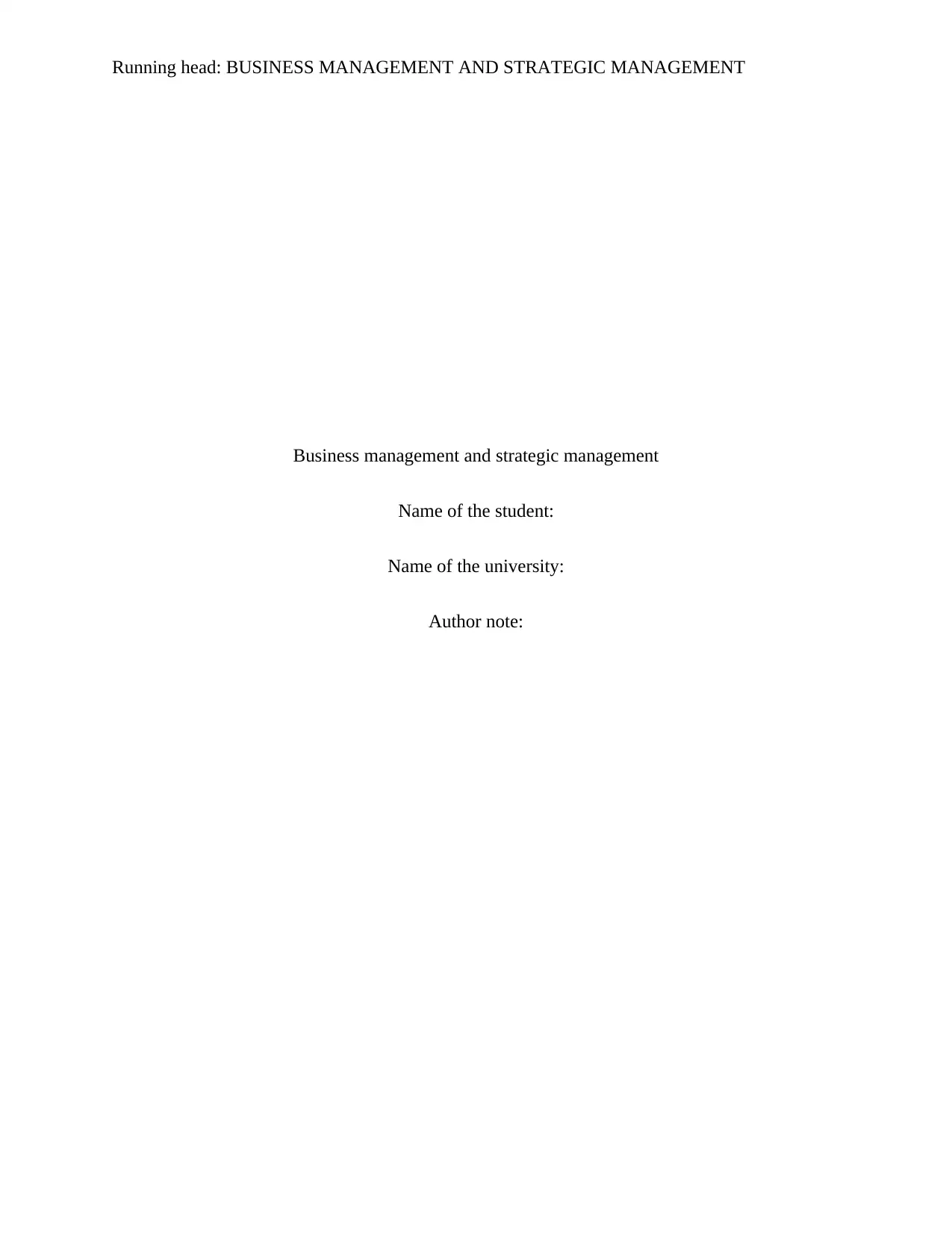
Running head: BUSINESS MANAGEMENT AND STRATEGIC MANAGEMENT
Business management and strategic management
Name of the student:
Name of the university:
Author note:
Business management and strategic management
Name of the student:
Name of the university:
Author note:
Paraphrase This Document
Need a fresh take? Get an instant paraphrase of this document with our AI Paraphraser
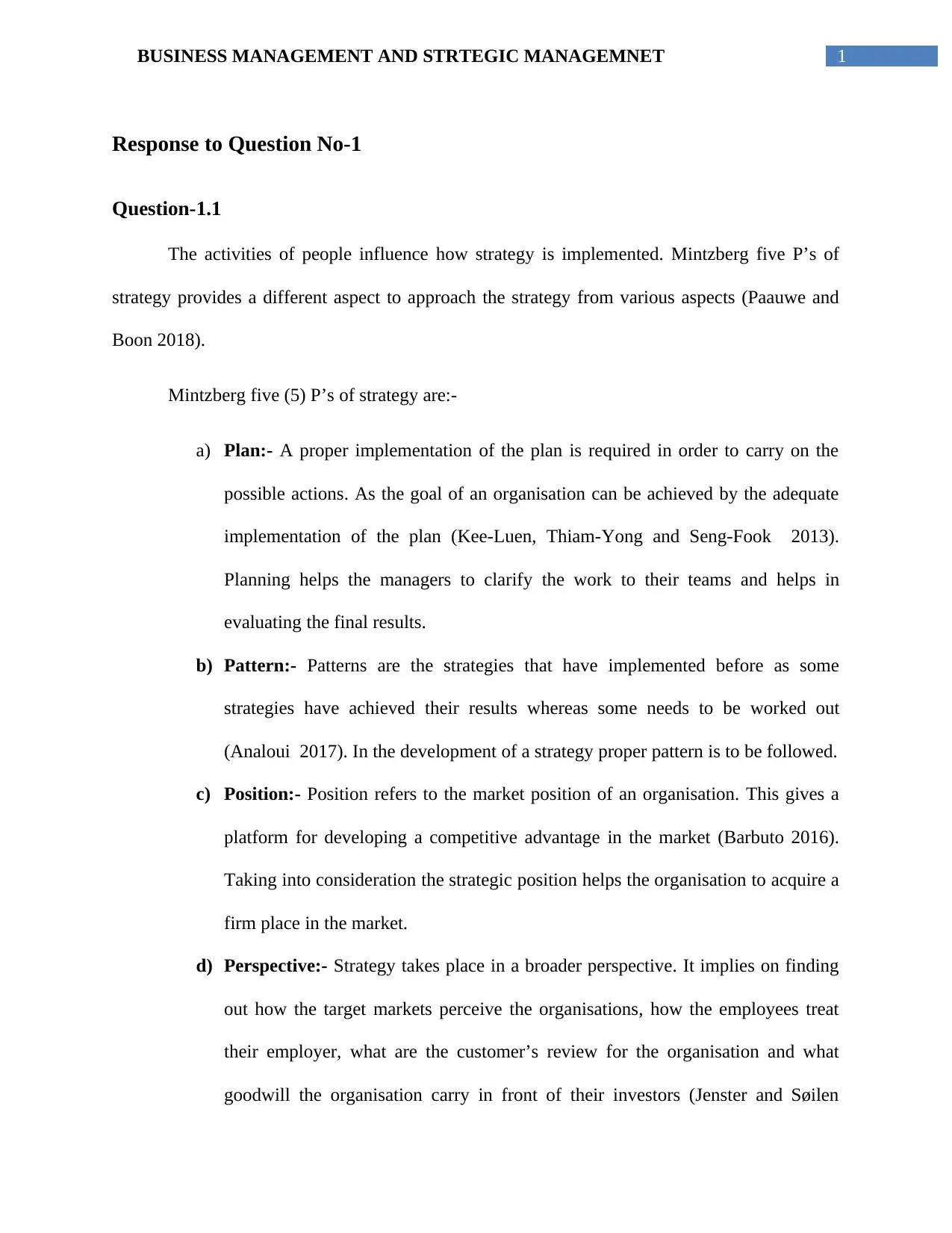
1BUSINESS MANAGEMENT AND STRTEGIC MANAGEMNET
Response to Question No-1
Question-1.1
The activities of people influence how strategy is implemented. Mintzberg five P’s of
strategy provides a different aspect to approach the strategy from various aspects (Paauwe and
Boon 2018).
Mintzberg five (5) P’s of strategy are:-
a) Plan:- A proper implementation of the plan is required in order to carry on the
possible actions. As the goal of an organisation can be achieved by the adequate
implementation of the plan (Kee-Luen, Thiam-Yong and Seng-Fook 2013).
Planning helps the managers to clarify the work to their teams and helps in
evaluating the final results.
b) Pattern:- Patterns are the strategies that have implemented before as some
strategies have achieved their results whereas some needs to be worked out
(Analoui 2017). In the development of a strategy proper pattern is to be followed.
c) Position:- Position refers to the market position of an organisation. This gives a
platform for developing a competitive advantage in the market (Barbuto 2016).
Taking into consideration the strategic position helps the organisation to acquire a
firm place in the market.
d) Perspective:- Strategy takes place in a broader perspective. It implies on finding
out how the target markets perceive the organisations, how the employees treat
their employer, what are the customer’s review for the organisation and what
goodwill the organisation carry in front of their investors (Jenster and Søilen
Response to Question No-1
Question-1.1
The activities of people influence how strategy is implemented. Mintzberg five P’s of
strategy provides a different aspect to approach the strategy from various aspects (Paauwe and
Boon 2018).
Mintzberg five (5) P’s of strategy are:-
a) Plan:- A proper implementation of the plan is required in order to carry on the
possible actions. As the goal of an organisation can be achieved by the adequate
implementation of the plan (Kee-Luen, Thiam-Yong and Seng-Fook 2013).
Planning helps the managers to clarify the work to their teams and helps in
evaluating the final results.
b) Pattern:- Patterns are the strategies that have implemented before as some
strategies have achieved their results whereas some needs to be worked out
(Analoui 2017). In the development of a strategy proper pattern is to be followed.
c) Position:- Position refers to the market position of an organisation. This gives a
platform for developing a competitive advantage in the market (Barbuto 2016).
Taking into consideration the strategic position helps the organisation to acquire a
firm place in the market.
d) Perspective:- Strategy takes place in a broader perspective. It implies on finding
out how the target markets perceive the organisations, how the employees treat
their employer, what are the customer’s review for the organisation and what
goodwill the organisation carry in front of their investors (Jenster and Søilen
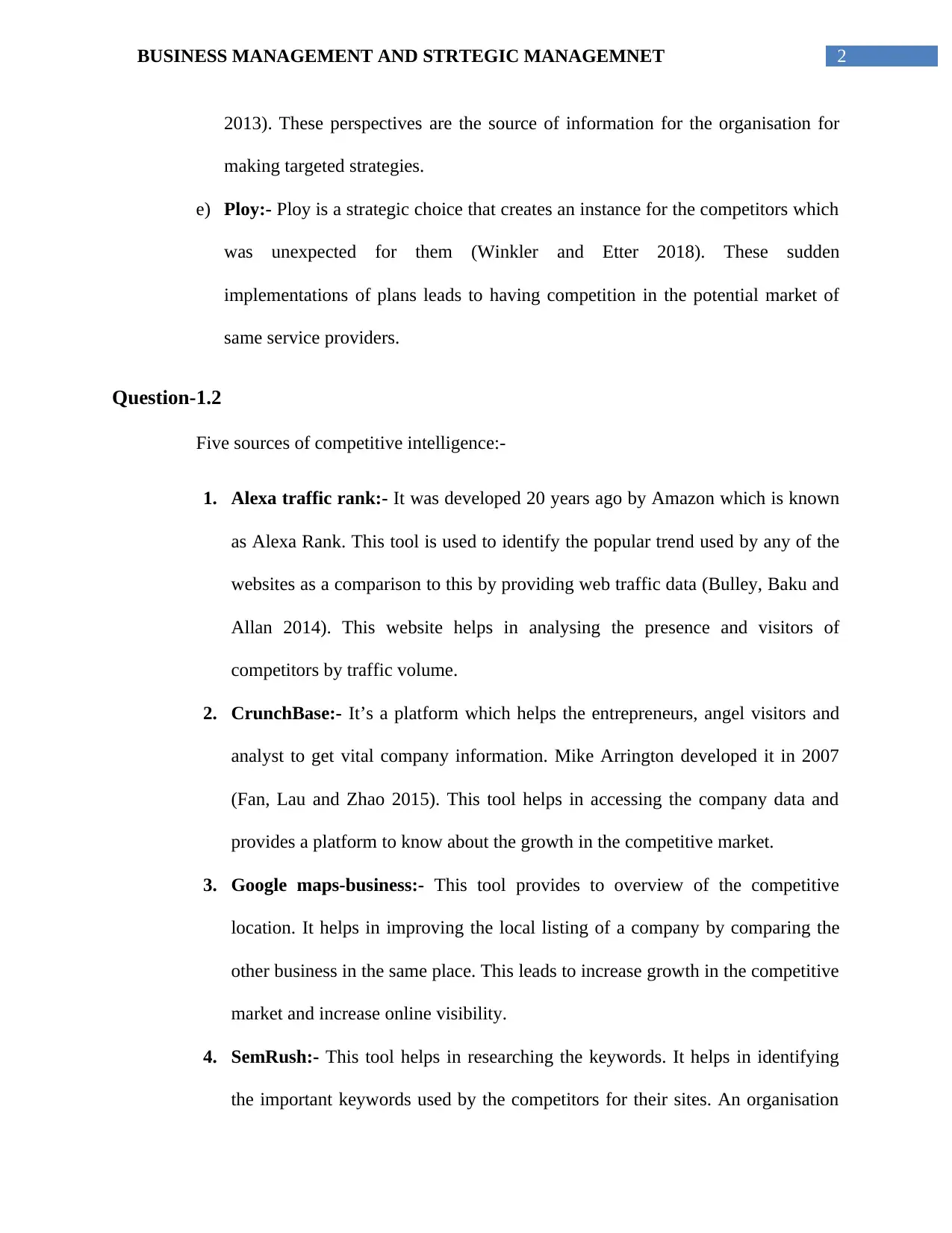
2BUSINESS MANAGEMENT AND STRTEGIC MANAGEMNET
2013). These perspectives are the source of information for the organisation for
making targeted strategies.
e) Ploy:- Ploy is a strategic choice that creates an instance for the competitors which
was unexpected for them (Winkler and Etter 2018). These sudden
implementations of plans leads to having competition in the potential market of
same service providers.
Question-1.2
Five sources of competitive intelligence:-
1. Alexa traffic rank:- It was developed 20 years ago by Amazon which is known
as Alexa Rank. This tool is used to identify the popular trend used by any of the
websites as a comparison to this by providing web traffic data (Bulley, Baku and
Allan 2014). This website helps in analysing the presence and visitors of
competitors by traffic volume.
2. CrunchBase:- It’s a platform which helps the entrepreneurs, angel visitors and
analyst to get vital company information. Mike Arrington developed it in 2007
(Fan, Lau and Zhao 2015). This tool helps in accessing the company data and
provides a platform to know about the growth in the competitive market.
3. Google maps-business:- This tool provides to overview of the competitive
location. It helps in improving the local listing of a company by comparing the
other business in the same place. This leads to increase growth in the competitive
market and increase online visibility.
4. SemRush:- This tool helps in researching the keywords. It helps in identifying
the important keywords used by the competitors for their sites. An organisation
2013). These perspectives are the source of information for the organisation for
making targeted strategies.
e) Ploy:- Ploy is a strategic choice that creates an instance for the competitors which
was unexpected for them (Winkler and Etter 2018). These sudden
implementations of plans leads to having competition in the potential market of
same service providers.
Question-1.2
Five sources of competitive intelligence:-
1. Alexa traffic rank:- It was developed 20 years ago by Amazon which is known
as Alexa Rank. This tool is used to identify the popular trend used by any of the
websites as a comparison to this by providing web traffic data (Bulley, Baku and
Allan 2014). This website helps in analysing the presence and visitors of
competitors by traffic volume.
2. CrunchBase:- It’s a platform which helps the entrepreneurs, angel visitors and
analyst to get vital company information. Mike Arrington developed it in 2007
(Fan, Lau and Zhao 2015). This tool helps in accessing the company data and
provides a platform to know about the growth in the competitive market.
3. Google maps-business:- This tool provides to overview of the competitive
location. It helps in improving the local listing of a company by comparing the
other business in the same place. This leads to increase growth in the competitive
market and increase online visibility.
4. SemRush:- This tool helps in researching the keywords. It helps in identifying
the important keywords used by the competitors for their sites. An organisation
⊘ This is a preview!⊘
Do you want full access?
Subscribe today to unlock all pages.

Trusted by 1+ million students worldwide
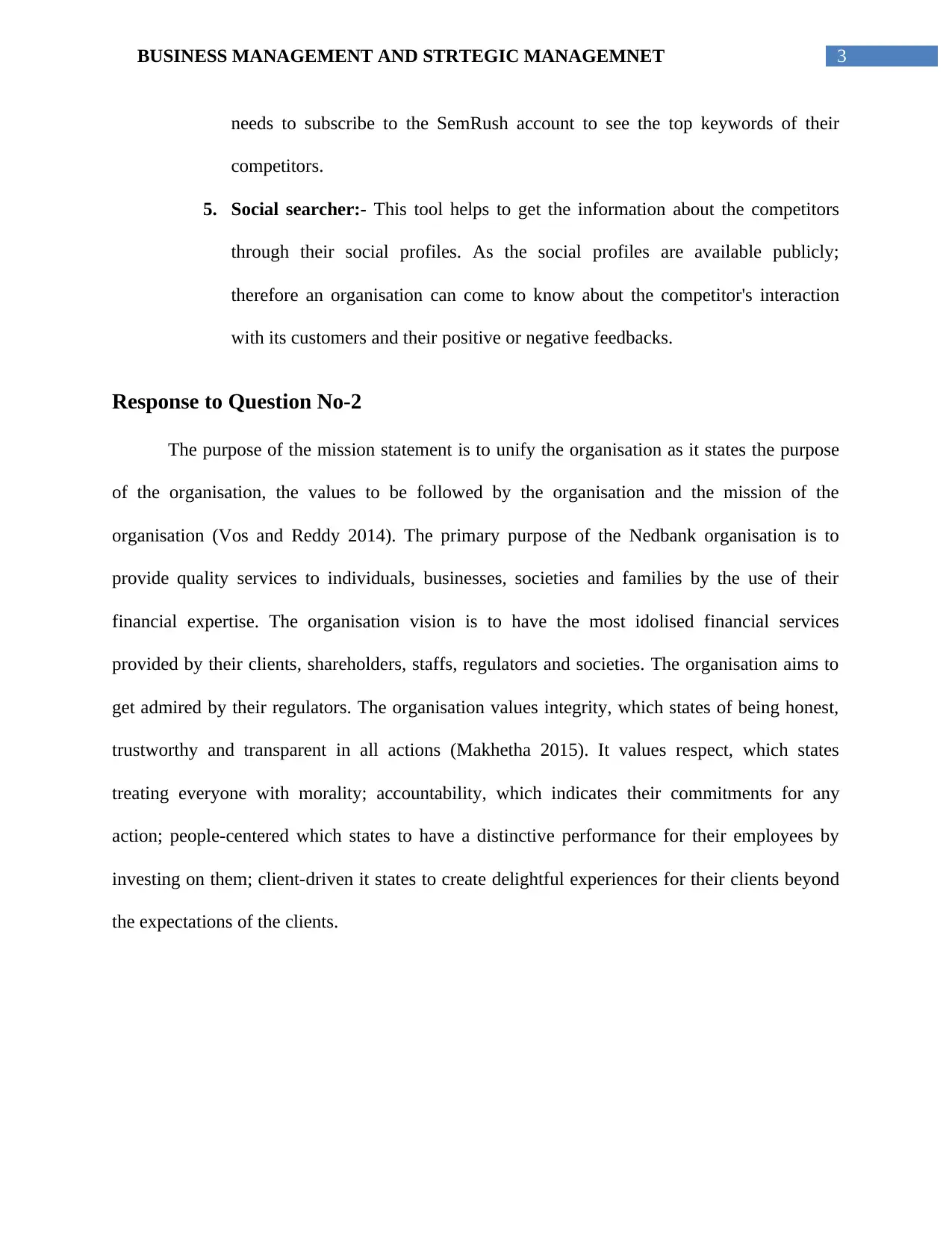
3BUSINESS MANAGEMENT AND STRTEGIC MANAGEMNET
needs to subscribe to the SemRush account to see the top keywords of their
competitors.
5. Social searcher:- This tool helps to get the information about the competitors
through their social profiles. As the social profiles are available publicly;
therefore an organisation can come to know about the competitor's interaction
with its customers and their positive or negative feedbacks.
Response to Question No-2
The purpose of the mission statement is to unify the organisation as it states the purpose
of the organisation, the values to be followed by the organisation and the mission of the
organisation (Vos and Reddy 2014). The primary purpose of the Nedbank organisation is to
provide quality services to individuals, businesses, societies and families by the use of their
financial expertise. The organisation vision is to have the most idolised financial services
provided by their clients, shareholders, staffs, regulators and societies. The organisation aims to
get admired by their regulators. The organisation values integrity, which states of being honest,
trustworthy and transparent in all actions (Makhetha 2015). It values respect, which states
treating everyone with morality; accountability, which indicates their commitments for any
action; people-centered which states to have a distinctive performance for their employees by
investing on them; client-driven it states to create delightful experiences for their clients beyond
the expectations of the clients.
needs to subscribe to the SemRush account to see the top keywords of their
competitors.
5. Social searcher:- This tool helps to get the information about the competitors
through their social profiles. As the social profiles are available publicly;
therefore an organisation can come to know about the competitor's interaction
with its customers and their positive or negative feedbacks.
Response to Question No-2
The purpose of the mission statement is to unify the organisation as it states the purpose
of the organisation, the values to be followed by the organisation and the mission of the
organisation (Vos and Reddy 2014). The primary purpose of the Nedbank organisation is to
provide quality services to individuals, businesses, societies and families by the use of their
financial expertise. The organisation vision is to have the most idolised financial services
provided by their clients, shareholders, staffs, regulators and societies. The organisation aims to
get admired by their regulators. The organisation values integrity, which states of being honest,
trustworthy and transparent in all actions (Makhetha 2015). It values respect, which states
treating everyone with morality; accountability, which indicates their commitments for any
action; people-centered which states to have a distinctive performance for their employees by
investing on them; client-driven it states to create delightful experiences for their clients beyond
the expectations of the clients.
Paraphrase This Document
Need a fresh take? Get an instant paraphrase of this document with our AI Paraphraser
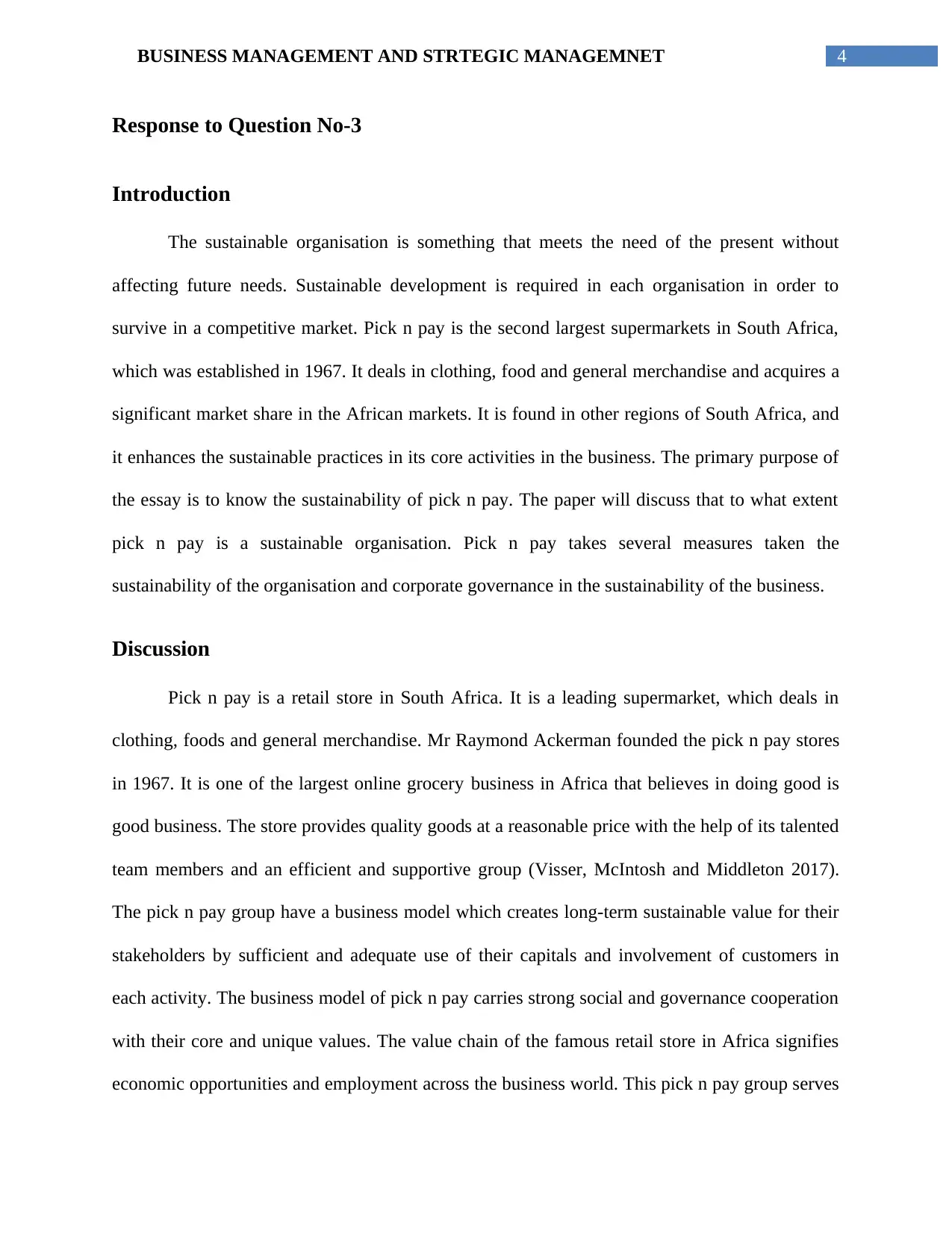
4BUSINESS MANAGEMENT AND STRTEGIC MANAGEMNET
Response to Question No-3
Introduction
The sustainable organisation is something that meets the need of the present without
affecting future needs. Sustainable development is required in each organisation in order to
survive in a competitive market. Pick n pay is the second largest supermarkets in South Africa,
which was established in 1967. It deals in clothing, food and general merchandise and acquires a
significant market share in the African markets. It is found in other regions of South Africa, and
it enhances the sustainable practices in its core activities in the business. The primary purpose of
the essay is to know the sustainability of pick n pay. The paper will discuss that to what extent
pick n pay is a sustainable organisation. Pick n pay takes several measures taken the
sustainability of the organisation and corporate governance in the sustainability of the business.
Discussion
Pick n pay is a retail store in South Africa. It is a leading supermarket, which deals in
clothing, foods and general merchandise. Mr Raymond Ackerman founded the pick n pay stores
in 1967. It is one of the largest online grocery business in Africa that believes in doing good is
good business. The store provides quality goods at a reasonable price with the help of its talented
team members and an efficient and supportive group (Visser, McIntosh and Middleton 2017).
The pick n pay group have a business model which creates long-term sustainable value for their
stakeholders by sufficient and adequate use of their capitals and involvement of customers in
each activity. The business model of pick n pay carries strong social and governance cooperation
with their core and unique values. The value chain of the famous retail store in Africa signifies
economic opportunities and employment across the business world. This pick n pay group serves
Response to Question No-3
Introduction
The sustainable organisation is something that meets the need of the present without
affecting future needs. Sustainable development is required in each organisation in order to
survive in a competitive market. Pick n pay is the second largest supermarkets in South Africa,
which was established in 1967. It deals in clothing, food and general merchandise and acquires a
significant market share in the African markets. It is found in other regions of South Africa, and
it enhances the sustainable practices in its core activities in the business. The primary purpose of
the essay is to know the sustainability of pick n pay. The paper will discuss that to what extent
pick n pay is a sustainable organisation. Pick n pay takes several measures taken the
sustainability of the organisation and corporate governance in the sustainability of the business.
Discussion
Pick n pay is a retail store in South Africa. It is a leading supermarket, which deals in
clothing, foods and general merchandise. Mr Raymond Ackerman founded the pick n pay stores
in 1967. It is one of the largest online grocery business in Africa that believes in doing good is
good business. The store provides quality goods at a reasonable price with the help of its talented
team members and an efficient and supportive group (Visser, McIntosh and Middleton 2017).
The pick n pay group have a business model which creates long-term sustainable value for their
stakeholders by sufficient and adequate use of their capitals and involvement of customers in
each activity. The business model of pick n pay carries strong social and governance cooperation
with their core and unique values. The value chain of the famous retail store in Africa signifies
economic opportunities and employment across the business world. This pick n pay group serves
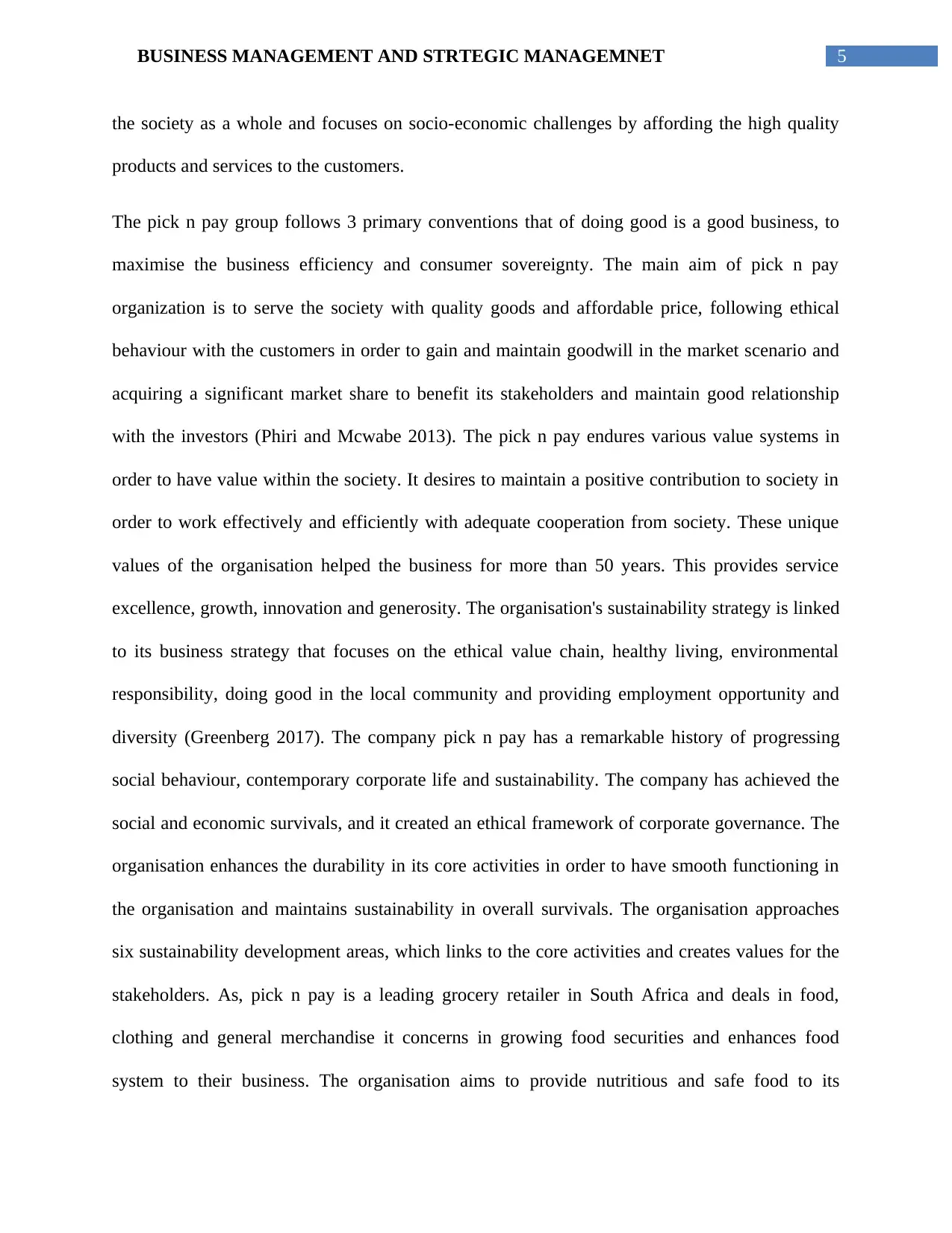
5BUSINESS MANAGEMENT AND STRTEGIC MANAGEMNET
the society as a whole and focuses on socio-economic challenges by affording the high quality
products and services to the customers.
The pick n pay group follows 3 primary conventions that of doing good is a good business, to
maximise the business efficiency and consumer sovereignty. The main aim of pick n pay
organization is to serve the society with quality goods and affordable price, following ethical
behaviour with the customers in order to gain and maintain goodwill in the market scenario and
acquiring a significant market share to benefit its stakeholders and maintain good relationship
with the investors (Phiri and Mcwabe 2013). The pick n pay endures various value systems in
order to have value within the society. It desires to maintain a positive contribution to society in
order to work effectively and efficiently with adequate cooperation from society. These unique
values of the organisation helped the business for more than 50 years. This provides service
excellence, growth, innovation and generosity. The organisation's sustainability strategy is linked
to its business strategy that focuses on the ethical value chain, healthy living, environmental
responsibility, doing good in the local community and providing employment opportunity and
diversity (Greenberg 2017). The company pick n pay has a remarkable history of progressing
social behaviour, contemporary corporate life and sustainability. The company has achieved the
social and economic survivals, and it created an ethical framework of corporate governance. The
organisation enhances the durability in its core activities in order to have smooth functioning in
the organisation and maintains sustainability in overall survivals. The organisation approaches
six sustainability development areas, which links to the core activities and creates values for the
stakeholders. As, pick n pay is a leading grocery retailer in South Africa and deals in food,
clothing and general merchandise it concerns in growing food securities and enhances food
system to their business. The organisation aims to provide nutritious and safe food to its
the society as a whole and focuses on socio-economic challenges by affording the high quality
products and services to the customers.
The pick n pay group follows 3 primary conventions that of doing good is a good business, to
maximise the business efficiency and consumer sovereignty. The main aim of pick n pay
organization is to serve the society with quality goods and affordable price, following ethical
behaviour with the customers in order to gain and maintain goodwill in the market scenario and
acquiring a significant market share to benefit its stakeholders and maintain good relationship
with the investors (Phiri and Mcwabe 2013). The pick n pay endures various value systems in
order to have value within the society. It desires to maintain a positive contribution to society in
order to work effectively and efficiently with adequate cooperation from society. These unique
values of the organisation helped the business for more than 50 years. This provides service
excellence, growth, innovation and generosity. The organisation's sustainability strategy is linked
to its business strategy that focuses on the ethical value chain, healthy living, environmental
responsibility, doing good in the local community and providing employment opportunity and
diversity (Greenberg 2017). The company pick n pay has a remarkable history of progressing
social behaviour, contemporary corporate life and sustainability. The company has achieved the
social and economic survivals, and it created an ethical framework of corporate governance. The
organisation enhances the durability in its core activities in order to have smooth functioning in
the organisation and maintains sustainability in overall survivals. The organisation approaches
six sustainability development areas, which links to the core activities and creates values for the
stakeholders. As, pick n pay is a leading grocery retailer in South Africa and deals in food,
clothing and general merchandise it concerns in growing food securities and enhances food
system to their business. The organisation aims to provide nutritious and safe food to its
⊘ This is a preview!⊘
Do you want full access?
Subscribe today to unlock all pages.

Trusted by 1+ million students worldwide
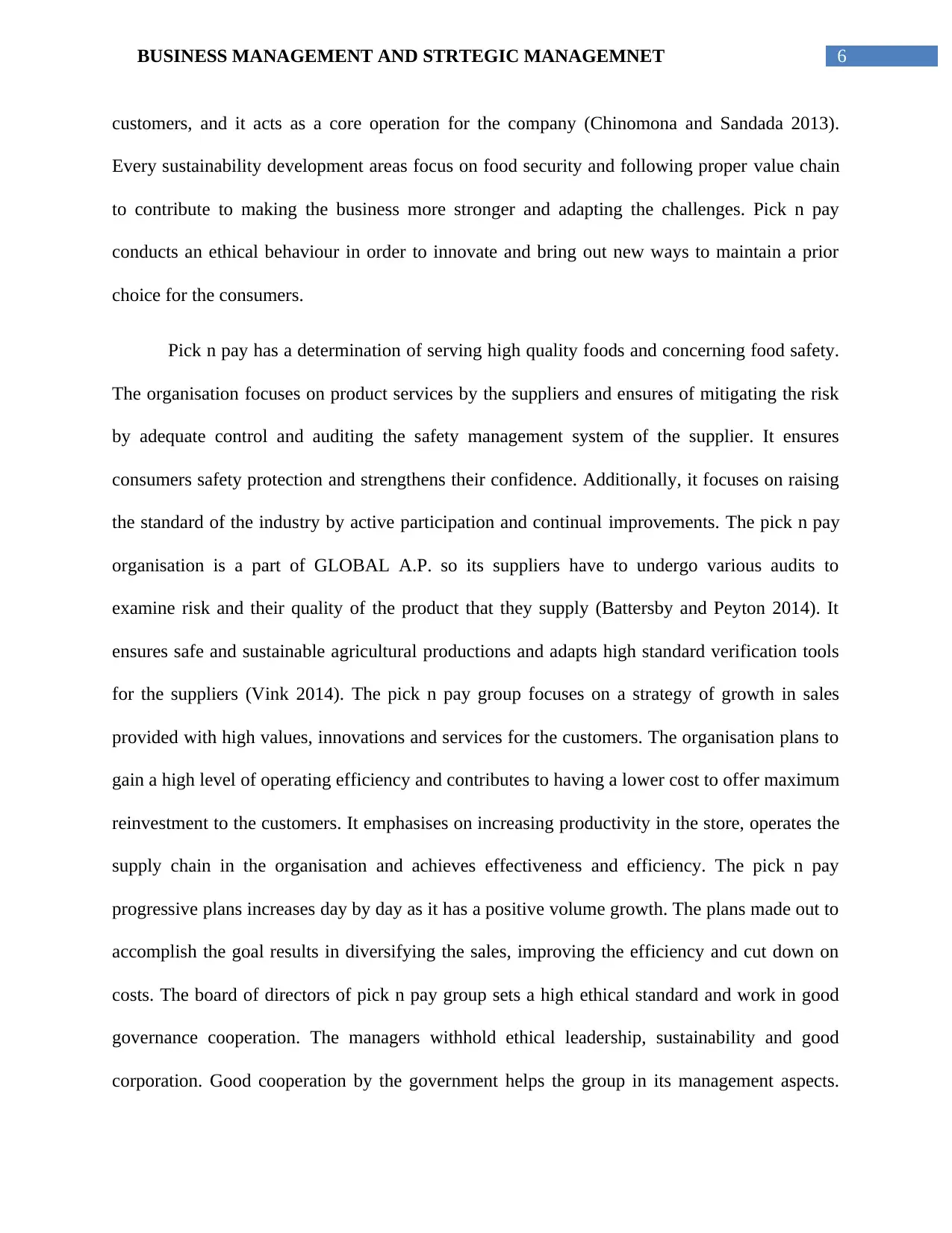
6BUSINESS MANAGEMENT AND STRTEGIC MANAGEMNET
customers, and it acts as a core operation for the company (Chinomona and Sandada 2013).
Every sustainability development areas focus on food security and following proper value chain
to contribute to making the business more stronger and adapting the challenges. Pick n pay
conducts an ethical behaviour in order to innovate and bring out new ways to maintain a prior
choice for the consumers.
Pick n pay has a determination of serving high quality foods and concerning food safety.
The organisation focuses on product services by the suppliers and ensures of mitigating the risk
by adequate control and auditing the safety management system of the supplier. It ensures
consumers safety protection and strengthens their confidence. Additionally, it focuses on raising
the standard of the industry by active participation and continual improvements. The pick n pay
organisation is a part of GLOBAL A.P. so its suppliers have to undergo various audits to
examine risk and their quality of the product that they supply (Battersby and Peyton 2014). It
ensures safe and sustainable agricultural productions and adapts high standard verification tools
for the suppliers (Vink 2014). The pick n pay group focuses on a strategy of growth in sales
provided with high values, innovations and services for the customers. The organisation plans to
gain a high level of operating efficiency and contributes to having a lower cost to offer maximum
reinvestment to the customers. It emphasises on increasing productivity in the store, operates the
supply chain in the organisation and achieves effectiveness and efficiency. The pick n pay
progressive plans increases day by day as it has a positive volume growth. The plans made out to
accomplish the goal results in diversifying the sales, improving the efficiency and cut down on
costs. The board of directors of pick n pay group sets a high ethical standard and work in good
governance cooperation. The managers withhold ethical leadership, sustainability and good
corporation. Good cooperation by the government helps the group in its management aspects.
customers, and it acts as a core operation for the company (Chinomona and Sandada 2013).
Every sustainability development areas focus on food security and following proper value chain
to contribute to making the business more stronger and adapting the challenges. Pick n pay
conducts an ethical behaviour in order to innovate and bring out new ways to maintain a prior
choice for the consumers.
Pick n pay has a determination of serving high quality foods and concerning food safety.
The organisation focuses on product services by the suppliers and ensures of mitigating the risk
by adequate control and auditing the safety management system of the supplier. It ensures
consumers safety protection and strengthens their confidence. Additionally, it focuses on raising
the standard of the industry by active participation and continual improvements. The pick n pay
organisation is a part of GLOBAL A.P. so its suppliers have to undergo various audits to
examine risk and their quality of the product that they supply (Battersby and Peyton 2014). It
ensures safe and sustainable agricultural productions and adapts high standard verification tools
for the suppliers (Vink 2014). The pick n pay group focuses on a strategy of growth in sales
provided with high values, innovations and services for the customers. The organisation plans to
gain a high level of operating efficiency and contributes to having a lower cost to offer maximum
reinvestment to the customers. It emphasises on increasing productivity in the store, operates the
supply chain in the organisation and achieves effectiveness and efficiency. The pick n pay
progressive plans increases day by day as it has a positive volume growth. The plans made out to
accomplish the goal results in diversifying the sales, improving the efficiency and cut down on
costs. The board of directors of pick n pay group sets a high ethical standard and work in good
governance cooperation. The managers withhold ethical leadership, sustainability and good
corporation. Good cooperation by the government helps the group in its management aspects.
Paraphrase This Document
Need a fresh take? Get an instant paraphrase of this document with our AI Paraphraser
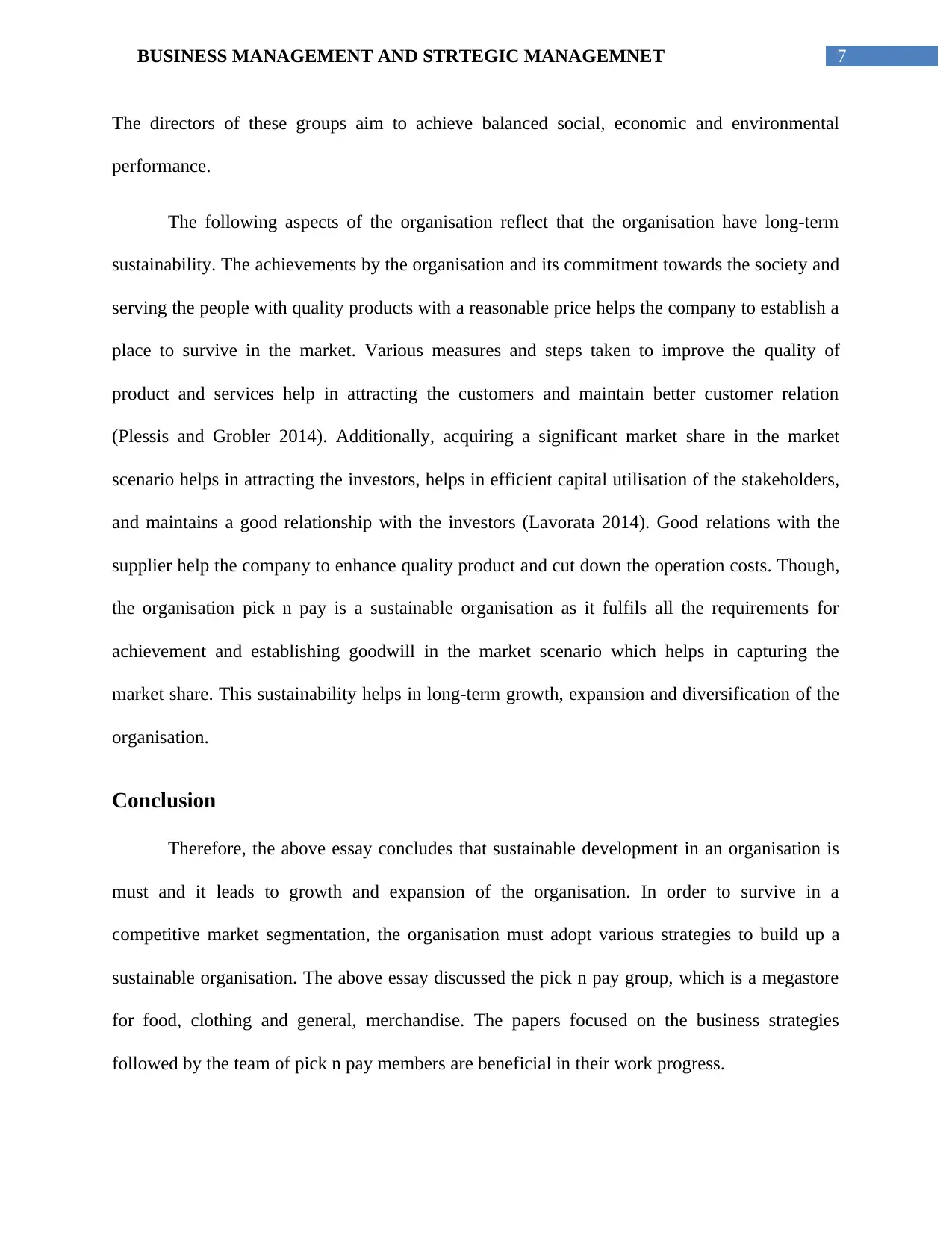
7BUSINESS MANAGEMENT AND STRTEGIC MANAGEMNET
The directors of these groups aim to achieve balanced social, economic and environmental
performance.
The following aspects of the organisation reflect that the organisation have long-term
sustainability. The achievements by the organisation and its commitment towards the society and
serving the people with quality products with a reasonable price helps the company to establish a
place to survive in the market. Various measures and steps taken to improve the quality of
product and services help in attracting the customers and maintain better customer relation
(Plessis and Grobler 2014). Additionally, acquiring a significant market share in the market
scenario helps in attracting the investors, helps in efficient capital utilisation of the stakeholders,
and maintains a good relationship with the investors (Lavorata 2014). Good relations with the
supplier help the company to enhance quality product and cut down the operation costs. Though,
the organisation pick n pay is a sustainable organisation as it fulfils all the requirements for
achievement and establishing goodwill in the market scenario which helps in capturing the
market share. This sustainability helps in long-term growth, expansion and diversification of the
organisation.
Conclusion
Therefore, the above essay concludes that sustainable development in an organisation is
must and it leads to growth and expansion of the organisation. In order to survive in a
competitive market segmentation, the organisation must adopt various strategies to build up a
sustainable organisation. The above essay discussed the pick n pay group, which is a megastore
for food, clothing and general, merchandise. The papers focused on the business strategies
followed by the team of pick n pay members are beneficial in their work progress.
The directors of these groups aim to achieve balanced social, economic and environmental
performance.
The following aspects of the organisation reflect that the organisation have long-term
sustainability. The achievements by the organisation and its commitment towards the society and
serving the people with quality products with a reasonable price helps the company to establish a
place to survive in the market. Various measures and steps taken to improve the quality of
product and services help in attracting the customers and maintain better customer relation
(Plessis and Grobler 2014). Additionally, acquiring a significant market share in the market
scenario helps in attracting the investors, helps in efficient capital utilisation of the stakeholders,
and maintains a good relationship with the investors (Lavorata 2014). Good relations with the
supplier help the company to enhance quality product and cut down the operation costs. Though,
the organisation pick n pay is a sustainable organisation as it fulfils all the requirements for
achievement and establishing goodwill in the market scenario which helps in capturing the
market share. This sustainability helps in long-term growth, expansion and diversification of the
organisation.
Conclusion
Therefore, the above essay concludes that sustainable development in an organisation is
must and it leads to growth and expansion of the organisation. In order to survive in a
competitive market segmentation, the organisation must adopt various strategies to build up a
sustainable organisation. The above essay discussed the pick n pay group, which is a megastore
for food, clothing and general, merchandise. The papers focused on the business strategies
followed by the team of pick n pay members are beneficial in their work progress.
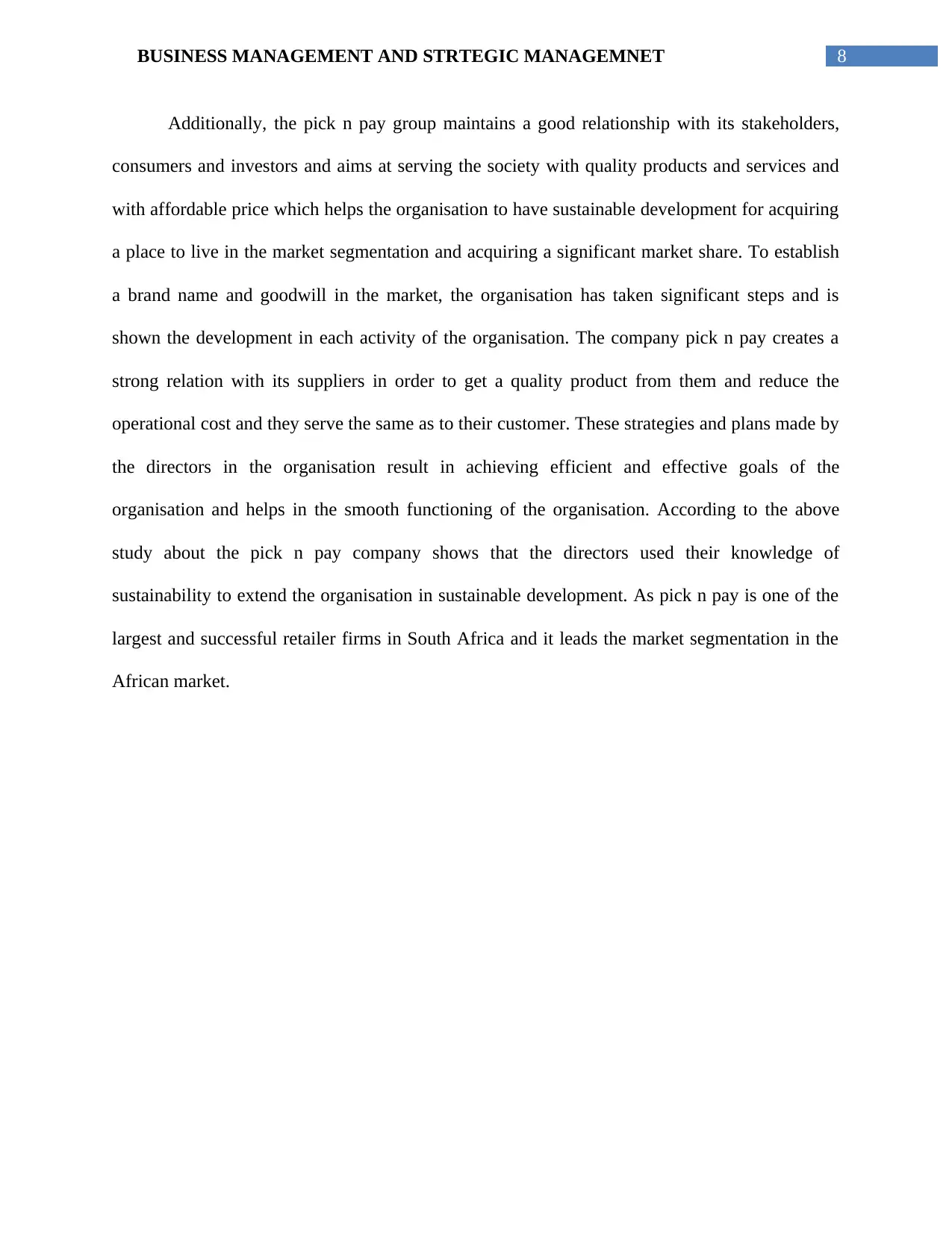
8BUSINESS MANAGEMENT AND STRTEGIC MANAGEMNET
Additionally, the pick n pay group maintains a good relationship with its stakeholders,
consumers and investors and aims at serving the society with quality products and services and
with affordable price which helps the organisation to have sustainable development for acquiring
a place to live in the market segmentation and acquiring a significant market share. To establish
a brand name and goodwill in the market, the organisation has taken significant steps and is
shown the development in each activity of the organisation. The company pick n pay creates a
strong relation with its suppliers in order to get a quality product from them and reduce the
operational cost and they serve the same as to their customer. These strategies and plans made by
the directors in the organisation result in achieving efficient and effective goals of the
organisation and helps in the smooth functioning of the organisation. According to the above
study about the pick n pay company shows that the directors used their knowledge of
sustainability to extend the organisation in sustainable development. As pick n pay is one of the
largest and successful retailer firms in South Africa and it leads the market segmentation in the
African market.
Additionally, the pick n pay group maintains a good relationship with its stakeholders,
consumers and investors and aims at serving the society with quality products and services and
with affordable price which helps the organisation to have sustainable development for acquiring
a place to live in the market segmentation and acquiring a significant market share. To establish
a brand name and goodwill in the market, the organisation has taken significant steps and is
shown the development in each activity of the organisation. The company pick n pay creates a
strong relation with its suppliers in order to get a quality product from them and reduce the
operational cost and they serve the same as to their customer. These strategies and plans made by
the directors in the organisation result in achieving efficient and effective goals of the
organisation and helps in the smooth functioning of the organisation. According to the above
study about the pick n pay company shows that the directors used their knowledge of
sustainability to extend the organisation in sustainable development. As pick n pay is one of the
largest and successful retailer firms in South Africa and it leads the market segmentation in the
African market.
⊘ This is a preview!⊘
Do you want full access?
Subscribe today to unlock all pages.

Trusted by 1+ million students worldwide
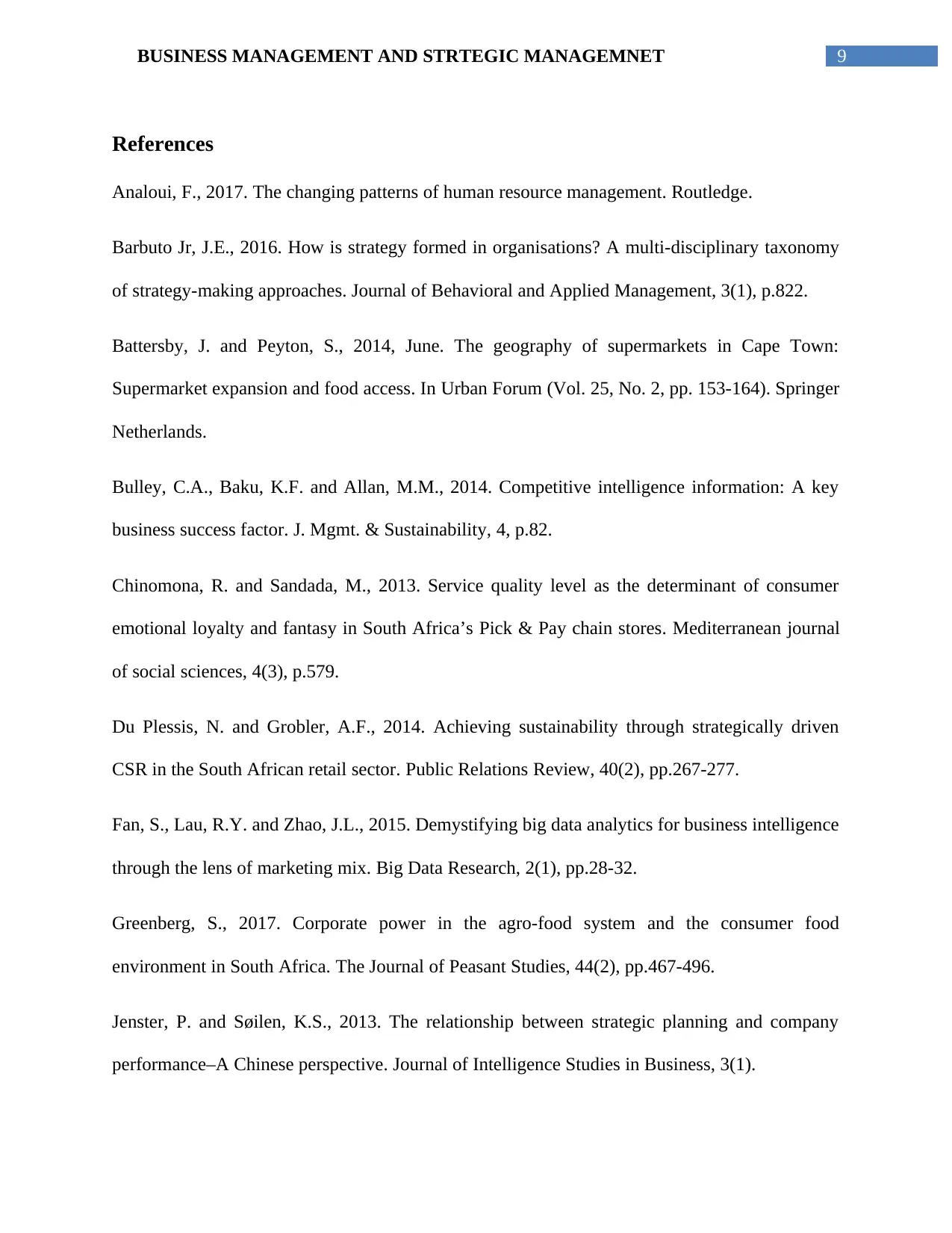
9BUSINESS MANAGEMENT AND STRTEGIC MANAGEMNET
References
Analoui, F., 2017. The changing patterns of human resource management. Routledge.
Barbuto Jr, J.E., 2016. How is strategy formed in organisations? A multi-disciplinary taxonomy
of strategy-making approaches. Journal of Behavioral and Applied Management, 3(1), p.822.
Battersby, J. and Peyton, S., 2014, June. The geography of supermarkets in Cape Town:
Supermarket expansion and food access. In Urban Forum (Vol. 25, No. 2, pp. 153-164). Springer
Netherlands.
Bulley, C.A., Baku, K.F. and Allan, M.M., 2014. Competitive intelligence information: A key
business success factor. J. Mgmt. & Sustainability, 4, p.82.
Chinomona, R. and Sandada, M., 2013. Service quality level as the determinant of consumer
emotional loyalty and fantasy in South Africa’s Pick & Pay chain stores. Mediterranean journal
of social sciences, 4(3), p.579.
Du Plessis, N. and Grobler, A.F., 2014. Achieving sustainability through strategically driven
CSR in the South African retail sector. Public Relations Review, 40(2), pp.267-277.
Fan, S., Lau, R.Y. and Zhao, J.L., 2015. Demystifying big data analytics for business intelligence
through the lens of marketing mix. Big Data Research, 2(1), pp.28-32.
Greenberg, S., 2017. Corporate power in the agro-food system and the consumer food
environment in South Africa. The Journal of Peasant Studies, 44(2), pp.467-496.
Jenster, P. and Søilen, K.S., 2013. The relationship between strategic planning and company
performance–A Chinese perspective. Journal of Intelligence Studies in Business, 3(1).
References
Analoui, F., 2017. The changing patterns of human resource management. Routledge.
Barbuto Jr, J.E., 2016. How is strategy formed in organisations? A multi-disciplinary taxonomy
of strategy-making approaches. Journal of Behavioral and Applied Management, 3(1), p.822.
Battersby, J. and Peyton, S., 2014, June. The geography of supermarkets in Cape Town:
Supermarket expansion and food access. In Urban Forum (Vol. 25, No. 2, pp. 153-164). Springer
Netherlands.
Bulley, C.A., Baku, K.F. and Allan, M.M., 2014. Competitive intelligence information: A key
business success factor. J. Mgmt. & Sustainability, 4, p.82.
Chinomona, R. and Sandada, M., 2013. Service quality level as the determinant of consumer
emotional loyalty and fantasy in South Africa’s Pick & Pay chain stores. Mediterranean journal
of social sciences, 4(3), p.579.
Du Plessis, N. and Grobler, A.F., 2014. Achieving sustainability through strategically driven
CSR in the South African retail sector. Public Relations Review, 40(2), pp.267-277.
Fan, S., Lau, R.Y. and Zhao, J.L., 2015. Demystifying big data analytics for business intelligence
through the lens of marketing mix. Big Data Research, 2(1), pp.28-32.
Greenberg, S., 2017. Corporate power in the agro-food system and the consumer food
environment in South Africa. The Journal of Peasant Studies, 44(2), pp.467-496.
Jenster, P. and Søilen, K.S., 2013. The relationship between strategic planning and company
performance–A Chinese perspective. Journal of Intelligence Studies in Business, 3(1).
Paraphrase This Document
Need a fresh take? Get an instant paraphrase of this document with our AI Paraphraser
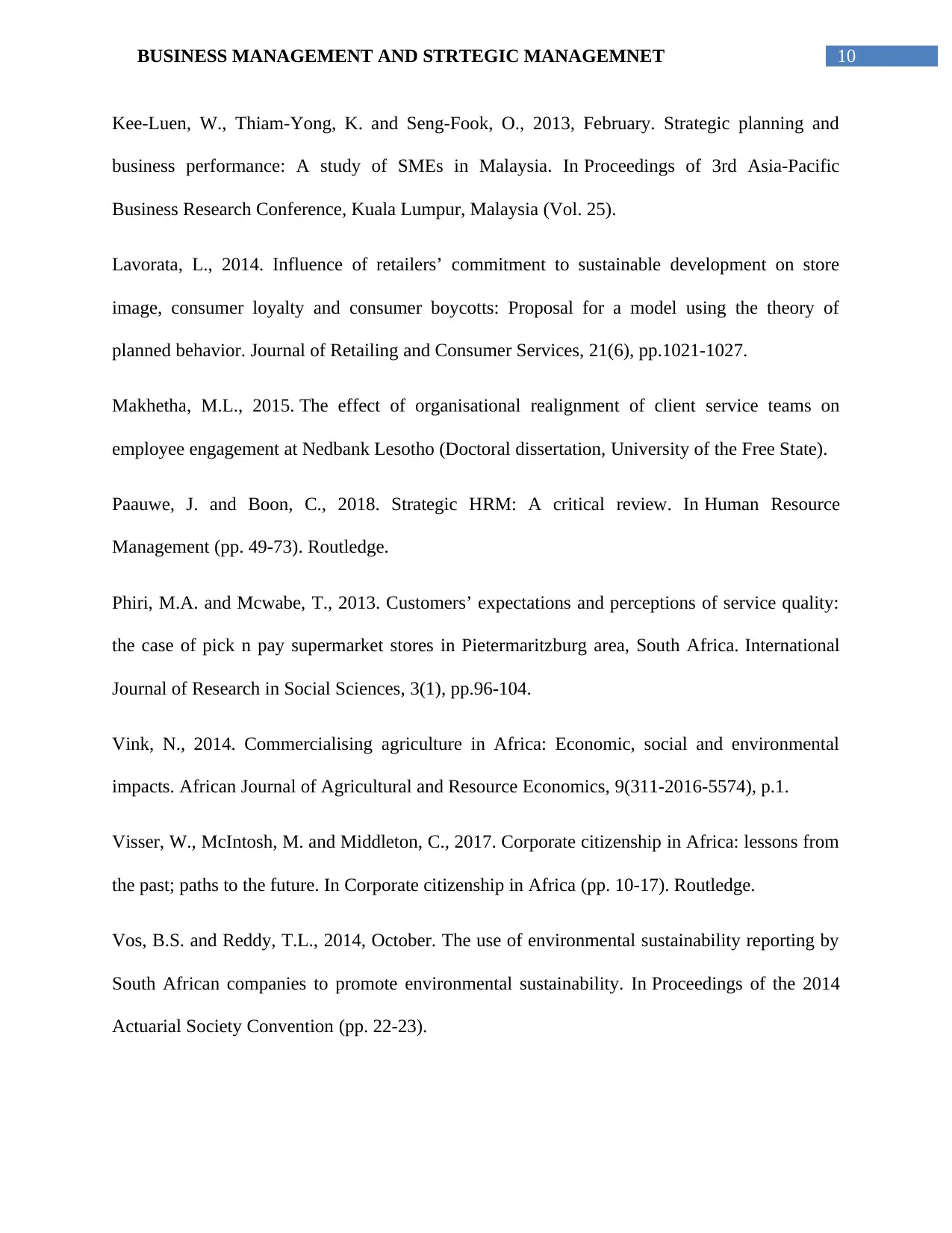
10BUSINESS MANAGEMENT AND STRTEGIC MANAGEMNET
Kee-Luen, W., Thiam-Yong, K. and Seng-Fook, O., 2013, February. Strategic planning and
business performance: A study of SMEs in Malaysia. In Proceedings of 3rd Asia-Pacific
Business Research Conference, Kuala Lumpur, Malaysia (Vol. 25).
Lavorata, L., 2014. Influence of retailers’ commitment to sustainable development on store
image, consumer loyalty and consumer boycotts: Proposal for a model using the theory of
planned behavior. Journal of Retailing and Consumer Services, 21(6), pp.1021-1027.
Makhetha, M.L., 2015. The effect of organisational realignment of client service teams on
employee engagement at Nedbank Lesotho (Doctoral dissertation, University of the Free State).
Paauwe, J. and Boon, C., 2018. Strategic HRM: A critical review. In Human Resource
Management (pp. 49-73). Routledge.
Phiri, M.A. and Mcwabe, T., 2013. Customers’ expectations and perceptions of service quality:
the case of pick n pay supermarket stores in Pietermaritzburg area, South Africa. International
Journal of Research in Social Sciences, 3(1), pp.96-104.
Vink, N., 2014. Commercialising agriculture in Africa: Economic, social and environmental
impacts. African Journal of Agricultural and Resource Economics, 9(311-2016-5574), p.1.
Visser, W., McIntosh, M. and Middleton, C., 2017. Corporate citizenship in Africa: lessons from
the past; paths to the future. In Corporate citizenship in Africa (pp. 10-17). Routledge.
Vos, B.S. and Reddy, T.L., 2014, October. The use of environmental sustainability reporting by
South African companies to promote environmental sustainability. In Proceedings of the 2014
Actuarial Society Convention (pp. 22-23).
Kee-Luen, W., Thiam-Yong, K. and Seng-Fook, O., 2013, February. Strategic planning and
business performance: A study of SMEs in Malaysia. In Proceedings of 3rd Asia-Pacific
Business Research Conference, Kuala Lumpur, Malaysia (Vol. 25).
Lavorata, L., 2014. Influence of retailers’ commitment to sustainable development on store
image, consumer loyalty and consumer boycotts: Proposal for a model using the theory of
planned behavior. Journal of Retailing and Consumer Services, 21(6), pp.1021-1027.
Makhetha, M.L., 2015. The effect of organisational realignment of client service teams on
employee engagement at Nedbank Lesotho (Doctoral dissertation, University of the Free State).
Paauwe, J. and Boon, C., 2018. Strategic HRM: A critical review. In Human Resource
Management (pp. 49-73). Routledge.
Phiri, M.A. and Mcwabe, T., 2013. Customers’ expectations and perceptions of service quality:
the case of pick n pay supermarket stores in Pietermaritzburg area, South Africa. International
Journal of Research in Social Sciences, 3(1), pp.96-104.
Vink, N., 2014. Commercialising agriculture in Africa: Economic, social and environmental
impacts. African Journal of Agricultural and Resource Economics, 9(311-2016-5574), p.1.
Visser, W., McIntosh, M. and Middleton, C., 2017. Corporate citizenship in Africa: lessons from
the past; paths to the future. In Corporate citizenship in Africa (pp. 10-17). Routledge.
Vos, B.S. and Reddy, T.L., 2014, October. The use of environmental sustainability reporting by
South African companies to promote environmental sustainability. In Proceedings of the 2014
Actuarial Society Convention (pp. 22-23).
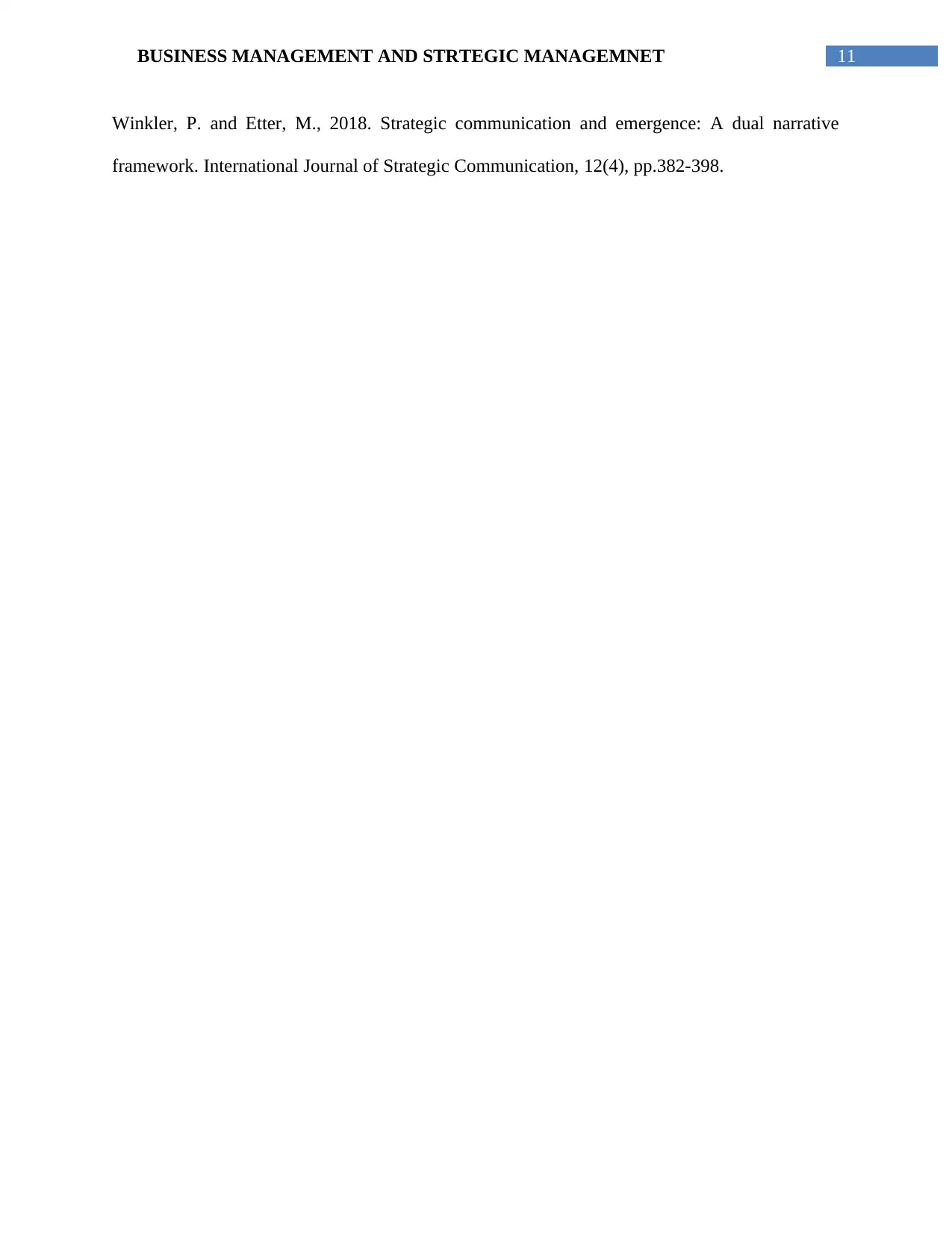
11BUSINESS MANAGEMENT AND STRTEGIC MANAGEMNET
Winkler, P. and Etter, M., 2018. Strategic communication and emergence: A dual narrative
framework. International Journal of Strategic Communication, 12(4), pp.382-398.
Winkler, P. and Etter, M., 2018. Strategic communication and emergence: A dual narrative
framework. International Journal of Strategic Communication, 12(4), pp.382-398.
⊘ This is a preview!⊘
Do you want full access?
Subscribe today to unlock all pages.

Trusted by 1+ million students worldwide
1 out of 12
Related Documents
Your All-in-One AI-Powered Toolkit for Academic Success.
+13062052269
info@desklib.com
Available 24*7 on WhatsApp / Email
![[object Object]](/_next/static/media/star-bottom.7253800d.svg)
Unlock your academic potential
Copyright © 2020–2025 A2Z Services. All Rights Reserved. Developed and managed by ZUCOL.




